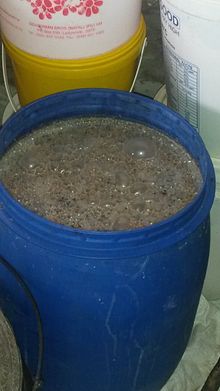Umqombothi
 |
|
| Type | Beer |
|---|---|
| Flavour | maize (corn), maize malt, sorghum malt, yeast |
Umqombothi (Xhosa pronunciation: [um̩k͡ǃomboːtʰi]), from the Xhosa language, is a beer made from maize (corn), maize malt, sorghum malt, yeast and water. It is commonly found in South Africa. It is very rich in Vitamin B. The beer has a rather low alcohol content (usually less than 3%) and is known to have a heavy and distinctly sour aroma. In appearance, the beer is opaque and light tan in colour. It has a thick, creamy and gritty consistency (from the maize).
Umqombothi is cheaper than commercial lager beers, that are brewed from barley and flavoured with hops flowers.
Umqombothi is brewed following traditional customs and these vary slightly between regions. The recipe is often passed down through the generations. The beer is traditionally prepared over a fire outside of the house. It then passively cools to ambient temperatures outside the house.
The ingredients used are: equal measures of maize meal, crushed mealie malt (corn malt) and crushed sorghum malt. The maize malt provides a lighter-toned beer with a mellower flavour. The sorghum malt provides a darker beer.
The ingredients are mixed in a cast-iron pot, known as a potjie in South Africa. Four measures of warm water are added. The mixture is left overnight. The mixture starts fermenting and bubbles appear. A sour odour can be detected.
A small portion of the wort is removed and put to one side. The remaining mash is cooked until a crusty sediment forms. This product is known as isidudu and can be eaten as a porridge. When making beer, the isidudu is left to cool for a day.
After the mixture has cooled, it is poured into a large plastic vat. The wort that was set aside is added to the vat. A handful of sorghum malt and a handful of maize malt is added to the vat. The brew is stirred with a traditional stirring spoon called an iphini. The vat is covered with a lid and blanket (to retain heat). The vat is put in a warm place overnight, to encourage fermentation.
...
Wikipedia
